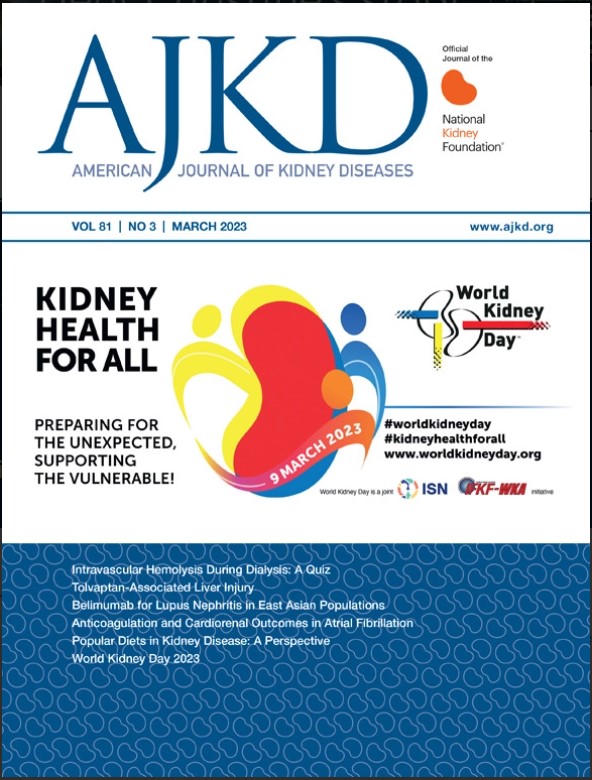尿素治疗抗利尿激素分泌不当综合征引起的低钠血症:系统回顾与元分析》。
IF 9.4
1区 医学
Q1 UROLOGY & NEPHROLOGY
引用次数: 0
摘要
理由与目标:由于存在有效性、安全性和耐受性方面的问题,使用尿素治疗与抗利尿激素分泌不当综合征(SIADH)相关的低钠血症尚未得到普遍采用。本研究对观察性研究进行了系统回顾和荟萃分析,旨在解决这些问题:研究人群:SIADH 相关低钠血症患者:SIADH相关低钠血症患者:临床试验和观察性研究,至少报告一项与血清钠浓度、症状缓解或口服或鼻饲尿素后的不良反应相关的结果:数据提取由两名审稿人独立完成,使用标准表格记录研究特征、参与者人口统计学特征、干预细节和治疗结果:采用随机效应模型的限制性最大似然法进行荟萃分析,评估尿素治疗与其他治疗方法相比对血清钠和血清尿素的影响。根据治疗持续时间和 SIADH 严重程度进行了分组分析:尿素治疗可明显增加 SIADH 患者的血清钠[平均差 (MD) = 9.08 (95%CI 7.64-10.52),p < 0.01]和尿素[平均差 (MD) = 31.66 (95%CI 16.05-47.26),p < 0.01],但异质性很高。根据治疗时间进行的亚组分析显示,治疗 24 小时、2 天、5 天、7 天和 14 天后以及治疗一年后,血清钠水平均有显著上升。重症患者在接受尿素治疗后血清钠水平的升高幅度更大(局限性:由于没有发现研究尿素治疗低钠血症的临床试验,因此这些分析是基于观察性研究:尿素治疗 SIADH 引起的低钠血症安全有效。这些发现表明,在资源有限的情况下,或当其他治疗方法被禁用或耐受性差时,尿素可能是一种有用的治疗方式。本文章由计算机程序翻译,如有差异,请以英文原文为准。
Urea to Treat Hyponatremia Due to Syndrome of Inappropriate Antidiuretic Hormone Secretion: A Systematic Review and Meta-Analysis
Rationale & Objective
The use of urea to treat hyponatremia related to the syndrome of inappropriate antidiuretic hormone secretion (SIADH) has not been universally adopted due to questions about effectiveness, safety, and tolerability. This systematic review and meta-analysis of observational studies addresses these questions.
Study Design
This PRISMA-guided study examined published research across 4 electronic databases.
Study Populations
Patients with SIADH-related hyponatremia.
Selection Criteria
Clinical trials and observational studies reporting at least 1 outcome related to serum sodium concentration, symptom resolution, or adverse effects after oral or nasogastric urea administration.
Data Extraction
Data extraction was performed independently by 2 reviewers using a standardized form recording study characteristics, participant demographics, intervention details, and treatment outcomes.
Analytical Approach
A meta-analysis was conducted using the restricted maximum likelihood method for the random effects model to assess the effect of urea treatment on serum sodium and serum urea compared with other treatment modalities. Subgroup analyses were conducted based on treatment duration and SIADH severity.
Results
Urea treatment significantly increased serum sodium (mean difference [MD], 9.08 [95% CI, 7.64-10.52], P < 0.01) and urea (MD, 31.66 [95% CI, 16.05-47.26], P < 0.01) in patients with SIADH, albeit with significantly high heterogeneity. Subgroup analysis based on the treatment duration showed a significant rise in the serum sodium level after 24 hours and 2, 5, 7, and 14 days, as well as after 1 year of treatment. Greater increases in serum sodium levels after treatment with urea occurred in patients with severe (<120 mEq/L) (MD, 18.04 [95% CI, 13.68-22.39]) than with moderate (120-129 mEq/L) (MD, 7.86 [95% CI, 6.78-8.94]) or mild (130-135 mEq/L) (MD, 8.00 [95% CI, 7.31-8.69]) SIADH-induced hyponatremia. Urea treatment was comparable to fluid restriction (MD, 0.81 [95% CI, −0.93 to 2.55], P = 0.4) and vaptans (MD, −1.96 [95% CI, −4.59 to 0.66], P = 0.1) but superior to no treatment (MD, 7.99 [95% CI, 6.25-9.72], P < 0.01). Urea was associated with minor adverse events, with poor palatability being the most common.
Limitations
As no randomized controlled trials investigating urea as a treatment for hyponatremia were identified for inclusion, these analyses were based on observational studies.
Conclusions
Urea is safe and effective for managing SIADH-induced hyponatremia. These finding suggest that urea may be a useful treatment modality in resource-limited settings or when other treatments are contraindicated or poorly tolerated.
Trial Registration
Registered at PROSPERO with study number CRD42024511685.
求助全文
通过发布文献求助,成功后即可免费获取论文全文。
去求助
来源期刊

American Journal of Kidney Diseases
医学-泌尿学与肾脏学
CiteScore
20.40
自引率
2.30%
发文量
732
审稿时长
3-8 weeks
期刊介绍:
The American Journal of Kidney Diseases (AJKD), the National Kidney Foundation's official journal, is globally recognized for its leadership in clinical nephrology content. Monthly, AJKD publishes original investigations on kidney diseases, hypertension, dialysis therapies, and kidney transplantation. Rigorous peer-review, statistical scrutiny, and a structured format characterize the publication process. Each issue includes case reports unveiling new diseases and potential therapeutic strategies.
 求助内容:
求助内容: 应助结果提醒方式:
应助结果提醒方式:


